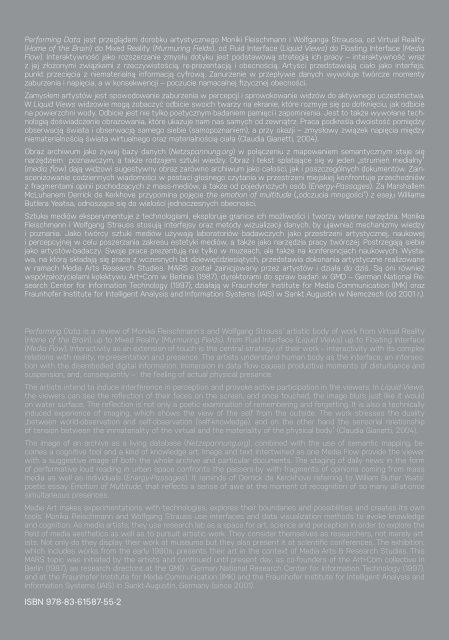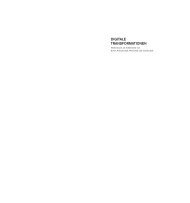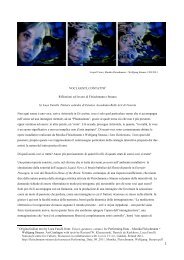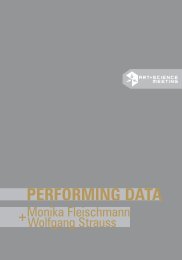Głosy, gesty, kontakt || Voices, gestures, contact
Voices, Gestures, Contact by Luca Farulli. Reflections about the work of Monika Fleischmann + Wolfgang Strauss. Luca Farulli writes about „Liquid Views“. „Liquid Views“ (1992/2013) is a simulation of artificial water in which the viewer’s reflection is portrayed as in real water. The computer as a storage media per se, artistically turned, tempts the visitor to leave its trace in the open system. Liquid Views predicts, cultural, social, technical and aesthetic changes that become evident 20 years later. In: Fleischmann, Monika; Strauss, Wolfgang: Performing Data | Performowanie danych with texts by Ryszard W. Kluszczyński, Derrick de Kerkhove (txt), Luca Farulli. National Centre for Culture, Warszawa 2011 with Laznia CCArt, Gdańsk, Poland 2011 ISBN 978-83-61587-55-2 http://fleischmann-strauss.de/resources/Luca-Farulli-VoicesGesturesContact-in-Performing_Data_2011.pdf
Voices, Gestures, Contact by Luca Farulli. Reflections about the work of Monika Fleischmann + Wolfgang Strauss.
Luca Farulli writes about „Liquid Views“. „Liquid Views“ (1992/2013) is a simulation of artificial water in which the viewer’s reflection is portrayed as in real water.
The computer as a storage media per se, artistically turned, tempts the visitor to leave its trace in the open system.
Liquid Views predicts, cultural, social, technical and aesthetic changes that become evident 20 years later.
In: Fleischmann, Monika; Strauss, Wolfgang: Performing Data | Performowanie danych with texts by Ryszard W. Kluszczyński, Derrick de Kerkhove (txt), Luca Farulli. National Centre for Culture, Warszawa 2011 with Laznia CCArt, Gdańsk, Poland 2011 ISBN 978-83-61587-55-2 http://fleischmann-strauss.de/resources/Luca-Farulli-VoicesGesturesContact-in-Performing_Data_2011.pdf
You also want an ePaper? Increase the reach of your titles
YUMPU automatically turns print PDFs into web optimized ePapers that Google loves.
Performing Data jest przeglądem dorobku artystycznego Moniki Fleischmann i Wolfganga Straussa, od Virtual Reality<br />
(Home of the Brain) do Mixed Reality (Murmuring Fields), od Fluid Interface (Liquid Views) do Floating Interface (Media<br />
Flow). Interaktywność jako rozszerzanie zmysłu dotyku jest podstawową strategią ich pracy – interaktywność wraz<br />
z jej złożonymi związkami z rzeczywistością, re-prezentacją i obecnością. Artyści przedstawiają ciało jako interfejs,<br />
punkt przecięcia z niematerialną informacją cyfrową. Zanurzenie w przepływie danych wywołuje twórcze momenty<br />
zaburzenia i napięcia, a w konsekwencji – poczucie namacalnej izycznej obecności.<br />
Zamysłem artystów jest spowodowanie zaburzenia w percepcji i sprowokowanie widzów do aktywnego uczestnictwa.<br />
W Liquid Views widzowie mogą zobaczyć odbicie swoich twarzy na ekranie, które rozmyje się po dotknięciu, jak odbicie<br />
na powierzchni wody. Odbicie jest nie tylko poetycznym badaniem pamięci i zapomnienia. Jest to także wywołane technologią<br />
doświadczenie obrazowania, które ukazuje nam nas samych od zewnątrz. Praca podkreśla dwoistość pomiędzy<br />
obserwacją świata i obserwacją samego siebie (samopoznaniem), a przy okazji – zmysłowy związek napięcia między<br />
niematerialnością świata wirtualnego oraz materialnością ciała (Claudia Gianetti, 2004).<br />
Obraz archiwum jako żywej bazy danych (Netzspannung.org) w połączeniu z mapowaniem semantycznym staje się<br />
narzędziem poznawczym, a także rodzajem sztuki wiedzy. Obraz i tekst splatające się w jeden „strumień medialny”<br />
(media low) dają widzowi su<strong>gesty</strong>wny obraz zarówno archiwum jako całości, jak i poszczególnych dokumentów. Zainscenizowanie<br />
codziennych wiadomości w postaci głośnego czytania w przestrzeni miejskiej konfrontuje przechodniów<br />
z fragmentami opinii pochodzących z mass-mediów, a także od pojedynczych osób (Energy-Passages). Za Marshallem<br />
McLuhanem Derrick de Kerkhove przypomina pojęcie the emotion of multitude („odczucia mnogości”) z eseju Williama<br />
Butlera Yeatsa, odnoszące się do wielości jednoczesnych obecności.<br />
Sztuka mediów eksperymentuje z technologiami, eksploruje granice ich możliwości i tworzy własne narzędzia. Monika<br />
Fleischmann i Wolfgang Strauss stosują interfejsy oraz metody wizualizacji danych, by ujawniać mechanizmy wiedzy<br />
i poznania. Jako twórcy sztuki mediów używają laboratoriów badawczych jako przestrzeni artystycznej, naukowej<br />
i percepcyjnej w celu poszerzania zakresu estetyki mediów, a także jako narzędzia pracy twórczej. Postrzegają siebie<br />
jako artystów-badaczy. Swoje prace prezentują nie tylko w muzeach, ale także na konferencjach naukowych. Wystawa,<br />
na którą składają się prace z wczesnych lat dziewięćdziesiątych, przedstawia dokonania artystyczne realizowane<br />
w ramach Media Arts Research Studies. MARS został zainicjowany przez artystów i działa do dziś. Są oni również<br />
współzałożycielami kolektywu Art+Com w Berlinie (1987), dyrektorami do spraw badań w GMD – German National Research<br />
Center for Information Technology (1997), działają w Fraunhofer Institute for Media Communication (IMK) oraz<br />
Fraunhofer Institute for Intelligent Analysis and Information Systems (IAIS) w Sankt Augustin w Niemczech (od 2001 r.).<br />
Performing Data is a review of Monika Fleischmann’s and Wolfgang Strauss’ artistic body of work from Virtual Reality<br />
(Home of the Brain) up to Mixed Reality (Murmuring Fields), from Fluid Interface (Liquid Views) up to Floating Interface<br />
(Media Flow). Interactivity as an extension of touch is the central strategy of their work – interactivity with its complex<br />
relations with reality, re-presentation and presence. The artists understand human body as the interface, an intersection<br />
with the disembodied digital information. Immersion in data low causes productive moments of disturbance and<br />
suspension, and, consequently – the feeling of actual physical presence.<br />
The artists intend to induce interference in perception and provoke active participation in the viewers. In Liquid Views,<br />
the viewers can see the relection of their faces on the screen, and once touched, the image blurs just like it would<br />
on water surface. The relection is not only a poetic examination of remembering and forgetting. It is also a technically<br />
induced experience of imaging, which shows the view of the self from the outside. The work stresses the duality<br />
„between world-observation and self-observation (self-knowledge), and on the other hand the sensorial relationship<br />
of tension between the immateriality of the virtual and the materiality of the physical body” (Claudia Gianetti, 2004).<br />
The image of an archive as a living database (Netzspannung.org), combined with the use of semantic mapping, becomes<br />
a cognitive tool and a kind of knowledge art. Image and text intertwined as one Media Flow provide the viewer<br />
with a suggestive image of both the whole archive and particular documents. The staging of daily news in the form<br />
of performative loud reading in urban space confronts the passers-by with fragments of opinions coming from mass<br />
media as well as individuals (Energy-Passages). It reminds of Derrick de Kerckhove referring to William Butler Yeats’<br />
poetic essay Emotion of Multitude, that relects a sense of awe at the moment of recognition of so many all-at-once<br />
simultaneous presences.<br />
Media Art makes experimentations with technologies, explores their boundaries and possibilities and creates its own<br />
tools. Monika Fleischmann and Wolfgang Strauss use interfaces and data visualization methods to evoke knowledge<br />
and cognition. As media artists, they use research lab as a space for art, science and perception in order to explore the<br />
ield of media aesthetics as well as to pursuit artistic work. They consider themselves as researchers, not merely artists.<br />
Not only do they display their work at museums but they also present it at scientiic conferences. The exhibition,<br />
which includes works from the early 1990s, presents their art in the context of Media Arts & Research Studies. This<br />
MARS topic was initiated by the artists and continued until present day, as co-founders of the Art+Com collective in<br />
Berlin (1987), as research directors at the GMD - German National Research Center for Information Technology (1997),<br />
and at the Fraunhofer Institute for Media Communication (IMK) and the Fraunhofer Institute for Intelligent Analysis and<br />
Information Systems (IAIS) in Sankt-Augustin, Germany (since 2001).<br />
ISBN 978-83-61587-55-2







